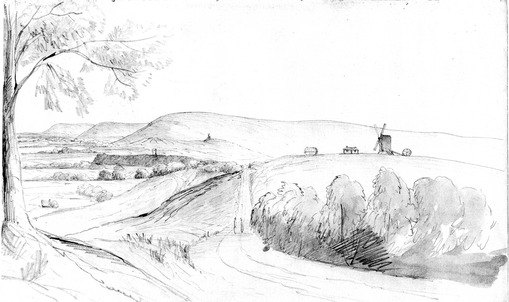The Bostal - Secrets of a Road - Museum May 16 News

Windmill above the Bostal
When it sets off from the cross roads at its foot it runs close to the parish boundary and you soon pass the spot where the skeleton of Steyning Man (on display in the Museum) was found, along with remnants of two other individuals. This spot must surely be within the boundaries of the Heathen Burials graveyard where, one thousand years ago, the Christian community of Steyning buried those who had transgressed in some way.
A little further up where Mount Park is now, and also just the other side of the road, chalk was quarried and burnt to create lime for fertilising the fields. Heat and smoke and wagons collecting the lime would have been a common sight.
As you get to the top of the first steep pitch and the road begins to flatten out, if you had looked up to the top of the ridge, you would have seen a windmill. How long it had been there when the owner, judging that it had become too rickety, blew it up with gunpowder in 1895 we are not sure. On the same site, during the Second World War, the Observer Corps established a post to look out for enemy planes. Another war-time precaution in the event of an invasion was the creation of a tank trap designed to stop enemy tanks, near the small quarry a bit further up. A ditch was dug into which fuel from a storage tank close by could be poured and ignited.
Until the road was metalled before the War the Bostal was sometimes known as "The Chalk Road". Its dusty surface was stabilised with flints. But it had been chosen as part of the turnpike road from Steyning to Worthing in the 1760's and it must have been a real challenge for even four horses to haul a loaded coach up the steepest part of the track, particularly in bad weather. It is still a matter for amazement to see cyclists, nowadays, riding up the steepest pitches.
Reaching the top of the Downs one arrives in an ancient landscape. Just on the left was a Bronze Age burial ground in which cremated bones were buried in jars. And, on the skyline to the right, was a tumulus (a circular burial mound). In 1951 Grammar School boys were active there, excavating before ploughing flattened it. They found skeletal remains which were judged to be from the early, pre-Christian, Saxon period. And, because the evidence of the dig has gone missing since then, that is how it might have ended. But the Bostal had a final trick up its sleeve. One of the boys lashed a skull to the back of his bike to take it back to the School and set off. He hit a bump in the road and the skull flew off breaking into several pieces. He must have done his best to rescue them and one fragment, with his signature on it, has come to light in an old School lumber room. With the help of modern technology we now know that this skull fragment, at least, is 500 years later than was expected.
In another 100 or 1000 years the Bostal will no doubt still wind its way up the steep face of the Downs but will have attracted yet more stories.
www.steyningmuseum.org.uk
We are open all year.
Mornings
Tuesday, Wednesday & Friday
from 10.30am to 12.30pm
Afternoons
Tuesday, Wednesday, Friday & Sunday
from 2.30pm to 4.30pm (1st April to 30th September)
and 2.30pm to 4.00pm (1st October to 31st March)
All day on Saturdays and Bank Holiday Mondays
from 10.30pm to 4.30pm (1st April to 30th September) and 10.30pm to 4.00pm (1st October to 31st March)
The Museum, Church Street, Steyning.
Telephone: 01903 813333

